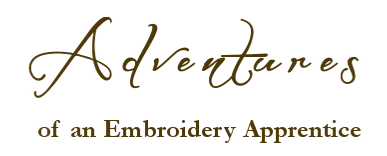Click on the images to enlarge them!
April - August 2019
Embroidered Mittens
An Interdisciplinary Project
It was a snowy Sunday morning in April, when upon waking up a spark crossed my mind: how about embroidered mittens for my daughter's birthday? She's a summer child and always chilly, and she goes to work on a bike even in winter. Basically, it was Mary Corbet who ignited this spark already over a year ago as she wrote a series on Hand Embroidery on Felted Wool Mittens. A word and a blow! Unfortunately, I don't have a sister (or even a friend) who would knit and felt a pair of mittens for me. I had to do the whole work myself.
Knitting - the Wrong Way
First thing I did was rummaging around a perceived fifty bags hosting my wool stash. Somewhere I had read, that only wool is suited for felting, no acrylics. Eventually, I found three left-over balls of dark brown wool. I knew that my daughter loves black and teal and red orange. But I had only brown, and in the face of the perceived fifty bags, I wasn't exactly in the mood to buy any more wool. The more so as I wasn't sure if there would be a presentable outcome at all. The fact was, that I didn't have a reliable instruction for knitting and felting with this exactly wool. It was a very old wool, you see. So be it! Dark brown isn't so far off of black, anyway.
First of all I knitted four tension squares in black, dark turquoise green, teal and brown, the first three being some kind of acrylic. I put them all three in the washer, together with three of my shawls, and laundered them at 40 °C (104 F) at the quick-wash program. And then a burst of laughter: the three acrylic samples didn't felt at all, of course, the wool did greatly, but eventually, one more felted shawl emerged - my sheer orange-red muslin shawl had felted, too! Too bad I didn't take a photo. 😄
When it comes to knitting, I generally turn to DROPS Design. It is a Norwegian website with thousands of free patterns and thorough, easy to understand instructions, accessible in a lot of languages. As it happens, I can't find the language selection right now, but when you enter "drops design", Google will recognise your location and show your language version in the first place. Of course, there were patterns for felted mittens, but they struck me as oddly huge, so I found myself another instruction in the internet, which claimed to have found the easiest way of knitting mittens by doing it crosswise rather than lengthwise. Don't get me started! I can't count how many times I unraveled the knitting and started over, just to realise that something in this instruction must be wrong! It just couln't work this way. Everything fell into place as I found a notice from the maintainer of the website saying that she had collected a great many instructions from other knitters, but did not review them, so she can't provide a guarantee that they all work properly. Thank you very much. 😖
Knitting Mittens Crosswise? Nope.
Knitting and Felting in 3 Approaches
Hence I must needs returned to the strangely huge mittens on DROPS Design. Of course, they used a different wool, meaning that I had to convert all measures, based not only on the knitting of my tension square, but I also had to consider the percentage of shrinking after felting the mittens. Each kind of wool has a different shrinking factor, after all. Don't ask me, how many times I realised that I made a mistake - either in calculating or in counting or in understanding as such ... I don't remember myself. For an instance, it was said to continue knitting from the cuff on with one thread each, which I didn't understand. So I continued with one thread only, until it dawned on me, that I should have been used two threads as before. The reason for my misunderstanding was that the instruction was designed for two colours of wool.
The first mitten looked like that:
Finished Mitten - First Attempt
After felting it in the same way as the tension squares, the mistakes came clear: the thumb was situated too hight, the cuff was too wide, and the top was too bulky, because I had pulled it together as stated in the instruction. Also I didn't like the board-like feel of the mitten. I thought that 2 threads might be too much, that I should work it with 1 thread only.
And so I did. How dumbstruck was I when I opened the washer drum. Just have a look yourself:
A Baby Mitten? 😁 😂
What did I do wrong? Obviously, a one-thread-knitting has a different shrinking factor than a two-thread-knitting.
Third and last attempt. The wool was using up. This time I worked both mittens at one go. If they wouldn't work out again, I would have to scrap the project, anyway. It was June 4, two months remaining till my daughter's birthday. I worked the thumbs at a lower position, and linked the end instead of pulling it together. Most notably, however, I decided to apply the count of stitches and rows as is in the instruction. I had got the impression, that their wool might be of a similar thickness and shrinking behaviour as mine.
Knitted Mittens - Last Attempt
As it happens, this time the knitting fairy was in good humour! The mittens came out of the washer in a perfect shape and state. What I wasn't sure about was my daughter's hand size. There was nothing for it but to wait and see.
Aaah! Knitting and Felting Finally Finished!
Besides, the instruction advised to stuff thumb and mitten with small plastic bags while washing in order to avoid them felting together at the inside. I found this a bit inconvenient, the more so as you have to fasten the bags with safety pins. On one occasion I forgot about it, and nothing bad happened.
Threadhunting Revisited
So, happily half of the work was done - now on to our favourite pastime, to wit embroidering. This part started happily, too, as I was drafting (or should I rather say "constructing"?) my designs in Inkscape. (Inkscape is a free vector graphics program, particularly suitable for producing very clean and precise outlines. SVG-files are unlimitedly scalable without quality loss.) It had to be sunflowers, since, as I said, my daughter is a summer child, and sunflowers are her favourite flowers. I had the idea to put a sunbeam over one and three raindrops over the other, for flowers need both sun and rain, right?
Sunflower Designs
Prior to transferring and stitching the designs, however, I had to chase down the embroidery threads. For stitching on thick, felted mittens, I wanted wool, crewel wool. There is no needlework shop for miles around, which means, that I had to find an online shop. But with two exceptions all German online shops carry tapestry wool only. Tapestry wool is much thicker than crewel wool, it wasn't suited for my project. The exceptions were Handarbeitshaus and a shop with the odd name "dkw constructions". Both offer Appleton crewel wool, unfortunately in a limited range of colours. I wasn't able to find other brands than that in all of Germany, and I had a list of a whole bunch of brands. Did I say Germany? In all of Europe! Only Fine d'Aubusson appeared in two French shops, but I didn't feel like taking the trouble of the high shipping charges. The trouble with ebay or etsy again is, that there are no photos, so that it is impossible for you to choose your colours.
As all was dazed and confused for good, I made my lucky find by coincidence - on the DMC website! I recollected their soft cotton, which I had confused with floche at one time. Soft cotton (or Coton Retors Mat pour tapisserie) is thicker and more woolly than floche. It is a tapestry thread, finer than tapestry wool. Is it, indeed? Did Mary Corbet write about it before? Of course she did! Likely as not, Mary has written about pretty everything by now. Here's her review. She was very fond of this thread, which, funnily enough, isn't availabe in the US (in contrast to DMC floche, which isn't available in Europe). She says: It’s definitely too thick for your typical crewel-design-on-linen type of embroidery, but it’s a really nice thread for embroidering on wool and flannel blanketing. What more could my heart desire? I ordered it immediately, filling the free shipping bill of € 15.00 (and even the shipping would have cost lousy € 2.95) with some skeins of Mouliné Satin, which is rayon and which I wanted to test.
The threads were shipped by the French parcel service Chronopost. On Friday, June 29, four days after placing the order, the tracking announced the parcel as delivered, though I hadn't got it yet. A short research showed, that the delivery was understood as to the depot of the German parcel service DPD only, located in Callenberg, not far from my location. Thus I was sure I would get it on Monday. But I didn't. I didn't get it neither on Tuesday nor on Wednesday. Still I thought I should wait till Friday, but something was goading me, and I dropped an email to the depot on Wednesday already, asking where my parcel is? And I'm glad I did! I got the immediate information that my parcel is ready for collection in one of my town's parcel shops (a tobacco and newspapers shop I didn't even know about) - since last Friday already! The salesclerk in the shop even had the gall to state, that they are recently restructuring, hence you should look after your parcels yourself in case you weren't notified!!! Had I indeed waited till Friday, as I originally had in mind to do, my parcel would have been returned to France!
Design Transfer
Transferring a design to a felted mitten is no mean feat. Actually, all the regular transfer methods - tracing on lightbox, iron-on transfer, carbon paper - are inapplicable. Even Prick & Pounce wouldn't work, for how would you manage to trace the dots on the felt? The only one method left is basting, and so I did. I printed the designs in the desired size, traced them on tissue paper (it has to be a very light weight paper that allows your needle to pierce through easily and that is easily removable, i.e. it should easily tear apart), pinned the tissue paper to the mitten and basted along all the lines in quite short stitches.
Transfer by Basting
In the course of the process, I learned by experience that the pattern becomes much more precise when basting it on in backstitch and tearing the paper carefully apart with tweezers, instead of ripping the paper apart from a running stitch. In the latter case you risk to yank the threads too much out of the felt, because the running stitch sits much looser than backstitch.
Embroidering Felted Mittens
The stitching went quite fine. Of course it was somewhat fiddly to anchor and cut the threads on the inside of the mitten, but with patience and some resourcefulness it wasn't impossible. Having such a relatively thick felt as a base, you best anchor your threads inside the felt layer. To do that, pull slowly and carefully against the thread, until it just disappears in the felt. Then work a few tiny backstitches in an area, where they will be covered by the embroidery. Similarly, you want to stitch using the "sewing method" by sliding your needle through the inside of the felt, not stabbing through to the inside of the mitten. This way, you prevent the threads later from getting caught by the fingernails of the wearer.
Embroidered Mittens
And here's the result.
Stems: stem stitch in 2 colours
Leaves: fly stitch in 2 colours
Petals: fishbone stitch
Flower heads: straight stitches with French knots on top
Raindrops: detached chain stitch (lazy daisy) with a white straight stitch in the centre
Sunbeams: whipped Holbein stitch
The birthday's long gone, the mittens were presented, they fit my daughter perfectly, and it seems that she enjoyed them.
Anyway, I have a strange feeling that I will never stitch on felt again ... For me, it's difficult to place the stitches exactly as I want them to be placed, when there's no warp and weft grid at all. With felt, when you put your needle in, you can never be sure how long the stitch will really be and how it will look after coming to the surface again. Felt is a bit like swimming in water: you're just not able to pinpoint the spot where you're going to cut the surface.



